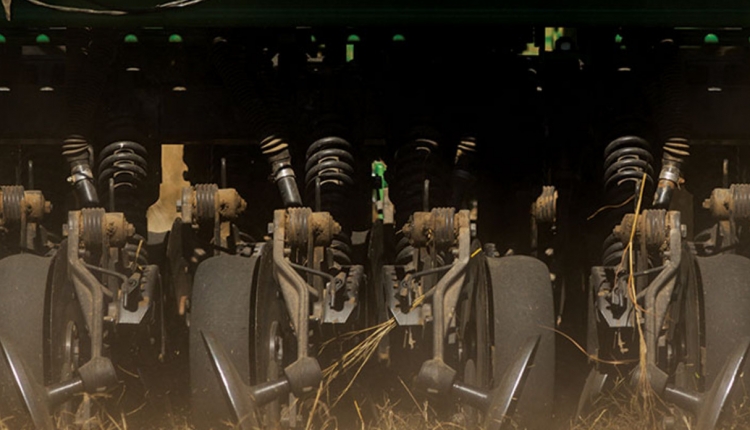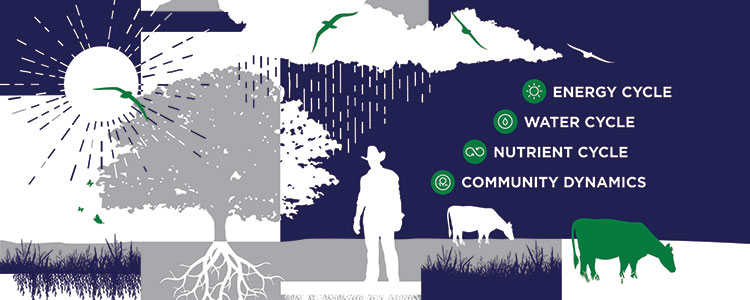The author is a senior agriculture consultant with the Noble Research Institute, Ardmore, Okla.

During fall, many producers in the South put a cover crop plan in to action — perhaps seeding small grains, winter peas, vetch, or clovers into their dormant warm-season, perennial grass pastures. Those grazing wheat pasture this winter may be planning a subsequent summer cover crop of sorghum, cowpeas, sunn hemp, sunflower, or other warm-season plants following harvest or graze-out.
At the Noble Research Institute, we look at cover crops as a versatile tool to consider when striving to improve the overall ecosystem of that land, which is more than just soil. It is a living system of communities that work together through four interconnected, naturally occurring ecosystem processes. These are the energy cycle, water cycle, nutrient cycle, and community dynamics. Let’s look at how cover crops can benefit each of the four.
Capture the sun’s energy
The energy cycle is the process by which plants use the sun’s energy to turn carbon dioxide into food for themselves and soil microbes, which in turn become forage for grazing animals and ultimately protein for humans.
Cover crops give us the opportunity to capture additional solar energy during more of the year. We also can improve the capture of solar energy by having different leaf shapes, leaf types, and architecture — long leaves, short leaves, tall plants, and short plants. Diverse plant types develop a more dense canopy to collect solar energy for the plant, the soil microbial community, and our grazing animals.
Improved soil properties
Water cycles through the soil ecosystem by means of evaporation, precipitation, infiltration, and transpiration. Just as cover crops add a variety of above-ground architecture options, they also provide different beneficial architectures below ground, such as deeper, potentially compaction-breaking roots that help open up the soil.
And as they attract soil life like earthworms, bacteria, and fungi, the cover crop roots help form good soil aggregates, which are clumps of individual soil particles stuck together that create pore spaces to allow water to soak into the ground and infiltrate.
Another way cover crops help the water cycle is by reducing raindrop impact. Rather than having bare soil exposed to the potential for both water and wind erosion as well as being subject to excess evaporation, it is protected by either the growing cover crop or the residue from a previous cover crop. More water goes into the soil and less runs off or evaporates, which makes the land more resilient against a future drought.
In Oklahoma, where a common winter pasture forage is wheat, using a summer cover crop to protect what might normally be bare soil is a good insulation strategy. Rather than letting the sun “bake” the water out of the field, plant a cover crop, let it grow big enough to cover the ground, then terminate the cover crop and use its residue to protect the soil. The dead plants aren’t using water, the soil surface is covered, and water is not being lost to evaporation.

Keep nutrients cycling
The nutrient cycle is basically the transfer of nutrients between living organisms and nonliving materials, with bacteria, fungi, and other microscopic life in the soil playing important roles in cycling nutrients from air and water so they are accessible to forage crops and the animals that eat them.
Again, the diversity of roots and root architectures that comes from a mixed cover crop can mine nutrients from different soil layers that our main forage crop doesn’t normally reach. Also, all plants are capturing energy, using photosynthesis to create sugar, and then leaking sugar from their roots. That leaked sugar attracts soil microbes – bacteria, fungi, protozoa, and actinomycetes — and feeds them. In turn, the microbes provide nitrogen, phosphorus, potassium and all the secondary nutrients to the plants.
Cover crops are a way that we can feed those soil microbes and benefit the nutrient cycle. Another way to help the cycle is if we are grazing cover crops and recycling nutrients back into the soil as manure.
Diversity drives community
Community dynamics are the changes to the ecosystem community structure and composition over time, including changes in microbiology, plant, and animal life. A high diversity of plants and functional groups will improve community dynamics. Adding cover crops to monoculture pastures improves plant diversity and ultimately community dynamics. A simplified way to think of it is like a town (community) that has only accountants versus one that has accountants, bakers, carpenters, doctors, electricians, firefighters, graphic designers, and so forth.
Another example of using cover crops with forage production is combining them with corn grown for silage. Harvesting silage can leave the soil bare, with no protective residue. Two effective ways to protect the soil and make that system better is to either include a cover crop with the corn so that the plant cover is already growing when the silage is taken off, or to plant a cover crop immediately after chopping silage.
A long-term investment
While there are costs associated with using cover crops, mainly for seed and planting, it’s helpful to look at growing cover crops as a long-term investment in your land and soil health. Even in the short term, it’s possible to offset input costs like herbicides and insecticides when the cover crops deter weeds by covering the soil and control pests by providing habitat for beneficial insects. Cover crops may also provide nitrogen and other major and minor nutrients that then don’t have to be purchased.
A higher functioning energy cycle, water cycle, nutrient cycle, and better community dynamics all add up to enhanced production in the long run, which leads to improved profits: However, cover crops are not a silver bullet. They are just one tool of many — like controlled burns, grazing, and adequate plant recovery time — to use in managing forage and grazing lands for optimum production and soil health.
This article appeared in the January 2022 issue of Hay & Forage Grower on pages 28 & 29.
Not a subscriber? Click to get the print magazine.

